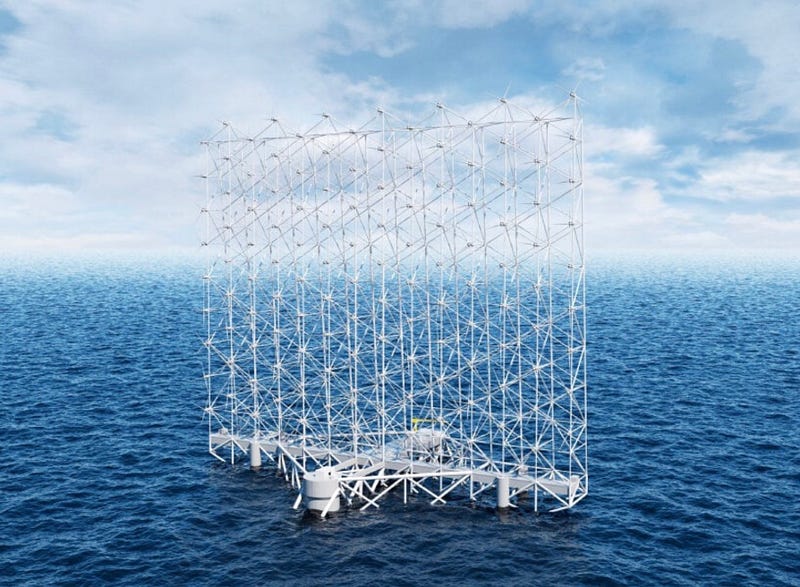Revolutionizing Offshore Wind Energy: The Wind Catching Solution
Written on
Chapter 1: The Promise of Offshore Wind Energy
In the ongoing battle against climate change, floating offshore wind energy has emerged as one of the most exciting alternatives. The ocean is home to an immense supply of wind energy, with an annual potential of 36,000 TWh—more than double the global consumption in 2022. Beyond its abundance, offshore wind is incredibly environmentally friendly, emitting only 6 grams of CO2 per kWh. This positions it among the cleanest energy sources available. Unlike solar or onshore wind, which can lead to habitat destruction, floating offshore wind can enhance marine biodiversity and biomass.
Yet, despite its benefits, the adoption of floating offshore wind has been hindered primarily by cost. With prices reaching up to $200 per MWh, it is pricier than nuclear power and significantly more so than solar energy. However, Wind Catching has devised a strategy to tackle these challenges and unlock this sustainable technology.
To grasp how Wind Catching's innovative design addresses these issues, we must first explore the limitations of conventional wind turbines, particularly their unsuitability for offshore deployment.
Section 1.1: The Evolution of Wind Turbines
Over the past two decades, wind turbines have increasingly favored larger, single-fan, three-blade configurations. This design minimizes turbulence between blades, allowing each to function optimally in clean air. The expanded size increases the swept area, capturing more wind and generating more power. These large fans are particularly efficient at low-to-moderate wind speeds, where the tips can generate significant apparent wind, enhancing energy production.
Kiteboarders experience a similar phenomenon; as they maneuver their kites, their pulling force is amplified, enabling impressive aerial jumps!
However, this single-fan design falters in high wind conditions. Larger, heavier blades have a lower RPM threshold due to the immense internal stresses they face, risking catastrophic failure. Moreover, when the tip speed exceeds 100 m/s, vibrations can lead to acoustic pollution and fatigue, necessitating shutdowns during peak wind events—ironically, the very times when wind energy is most abundant.
As a result, traditional turbines deployed offshore frequently remain inactive, yielding less energy than their onshore counterparts despite the stronger winds available at sea. The complexity of offshore installations further exacerbates costs.
Subsection 1.1.1: Understanding Wind Catching's Innovation

This is where Wind Catching introduces its groundbreaking design. Instead of a single large fan, each Wind Catching unit features a sprawling 300-by-300-meter array of smaller fans. While these smaller fans may be less efficient at lower wind speeds, they are engineered to withstand hurricane-force winds without structural failure. Notably, the overall swept area of these units is roughly double that of current wind turbine technologies.
Section 1.2: The Benefits of Wind Catching
According to Wind Catching, their design harnesses energy from high wind speeds effectively, generating 2.5 times more annual energy per swept area than traditional turbines. With double the area of a standard 15 MW turbine, each Wind Catching unit can produce five times the annual energy output. This efficiency means fewer units are required, simplifying installation and maintenance, thus reducing overall costs.
To illustrate this efficiency, five Wind Catching units could yield the same energy output as 25 conventional 15 MW offshore wind turbines. Additionally, their compact nature is expected to be more beneficial for marine ecosystems, especially in shallower waters.
Chapter 2: The Path Forward
The innovative construction of Wind Catching units also streamlines installation and maintenance processes, allowing for the use of non-specialized vessels, thereby cutting costs further. Wind Catching claims that its design could deliver floating offshore energy at grid parity prices. Historically, the UK's average cost was just under £50 ($60) per MWh from 2001 to 2022. If Wind Catching can achieve this target, it would represent a staggering 70% cost reduction, removing a significant barrier to harnessing this eco-friendly energy source.
But can Wind Catching meet this ambitious goal? The foundational concept appears promising, but the journey from concept to large-scale implementation is fraught with challenges. Fortunately, Wind Catching has secured several million dollars in funding to develop and test a proof of concept. With the potential to revolutionize offshore wind energy, we can only hope they succeed in this endeavor.
The first video titled "Here's What's Going Wrong in the US Offshore Wind Industry" sheds light on the current challenges faced by the offshore wind sector in the US, discussing potential solutions and future directions.
The second video, "Engineering with Rosie Live Ep. 1 Weird Wind - Vortex Bladeless," explores innovative engineering solutions in wind technology, including the unique Vortex Bladeless design, which offers insights into alternative approaches to harnessing wind energy.
Enjoyed this article? If so, consider checking out my latest book, “50 Ways To Save The World,” available on Amazon.